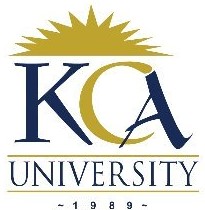 UNIVERSITY EXAMINATIONS: 2016/2017
UNIVERSITY EXAMINATIONS: 2016/2017
ORDINARY EXAMINATION FOR THE DEGREES OF BACHELOR OF
SCIENCE IN INFORMATION TECHNOLOGY /BACHELOR OF BUSINESS
IN INFORMATION TECHNOLOGY
BIT2103 BBIT200 PRINCIPLES OF ARTIFICIAL INTELLIGENCE
FULLTIME/PART TIME/DISTANCE LEARNING
DATE: AUGUST, 2017 TIME: 2 HOURS
INSTRUCTIONS: Answer Question One & ANY OTHER TWO questions.
QUESTION ONE
(a) Briefly explain the meaning of the following concepts with reference to artificial intelligence
i) Artificial intelligence (2 Marks)
ii) Intelligent agents (2 Marks)
(b) Distinguish between Intrapersonal and interpersonal intelligence. State potential careers and
techniques used for improving each intelligence (4 Marks)
(c) Write whether each statement is true (T) or false (F), and provide a short explanation:
( i) Both breadth-first and depth first search are inefficient (2 Marks)
(ii) Uniform-cost search is optimal (2 Marks)
(iii) Greedy search is complete (2 Marks)
(d) Briefly explain three applications of artificial intelligence techniques (3 Marks)
(e) Consider the following knowledgebase of a certain family
father_of (peter, fred) .
father_of (peter, tom).
father_of (james,david).
gender (tom, male)
student (tom, KCAU).
(f) Formulate predicate- logic queries that can be typed in Prolog to find the following knowledge
(i) a list of all the fathers (2 Marks)
(ii) all the children of peter. (2 Marks)
(iii) Confirm the existence of a kcau student known as tom (2 Marks)
(g) Briefly describe two categories of artificial intelligence tasks. Give one example for each case.
(4 Marks)
(h) Given that p is true and q is false, construct a truth table that shows the truth value for the
following expression: (2 Marks)
![]()
(i) Define the term ‘expert system’ (1 Mark)
QUESTION TWO
a) Briefly explain the meaning of the following concepts. Give one example of potential career for
each case
(i) Linguistic Intelligence (2 Marks)
(ii) Spacial intelligence (2 Marks)
(iii) Bodily kinesthetic intelligence (2 Marks)
d) Consider the following propositions
Cat is mammal, mammal is an animal, cat has fur, and bear has fur
(i) Construct Semantic Network (4 Marks)
(ii) Convert the semantic network constructed in (3d) into predicate logic (2 Marks)
(e) Explain four limitations of expert systems in the context of artificial intelligence (4 Marks)
(f).Explain two elements that can be used to represent uncertainty in fuzzy logic reasoning
Give one example for each element. (4 Marks)
QUESTION THREE
(a) Briefly explain the meaning of the following terms
( i) Robot (2 Marks)
(ii) Intelligent agent (2 Marks)
(iii) Agent environment (2 Marks)
(b) Describe any two applications of a robot in the industry (2 Marks)
(c) State and explain three types of mobile robots (3 Marks)
(d) Briefly explain four characteristics of a robot (4 Marks)
(e) State and explain five parts of a robot (5 Marks)
QUESTION FOUR
(a)Describe the meaning of the following terms in the context of artificial intelligence
(i) Inferencing (2 Marks)
(ii) Solution (2 Marks)
(iii) Firing of a rule (2 Marks)
(iv) Heuritics (2 Marks)
(b) State and explain four inferencing methods (4 Marks)
(c) Describe four characteristics of a good knowledge representation technique (4 Marks)
(d) If Z croaks and eats flies – Then Z is a frog.
If Z fly – Then Z it is a bird.
If Z is a frog – Then Z is green
If Z is a canary – Then Z is yellow
Suppose you have a pet that croaks and eats flies. Use forward chain to determine the colour of the
pet? (4 Marks)
QUESTION FIVE
(a) Briefly describe the meaning of the term ‘search problem’ (2 Marks)
(b).State and explain five elements of defining search problem. (5 Marks)
(c). Describe three characteristics of un informed searching methods. (3 Marks)
(d). Consider the search tree shown Figure below.
(i)Use depth first search algorithm to find a path from S to E. What is the path cost?
(4 Marks)
(ii) Use breadth first algorithm find a path from S to C. Specify the path cost (4 Marks)
(e) . Consider the following figure
Specify the state space represented in the above figure (2 Marks)